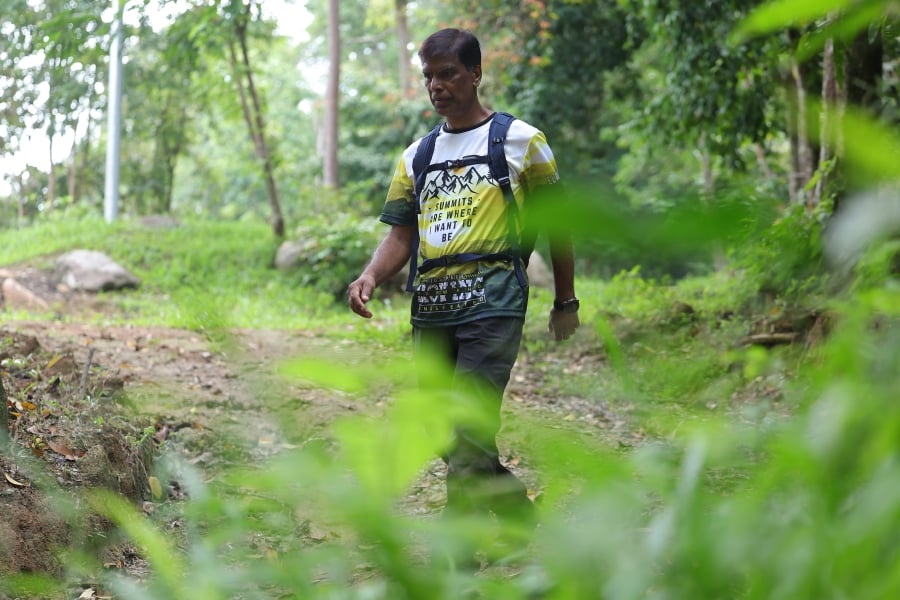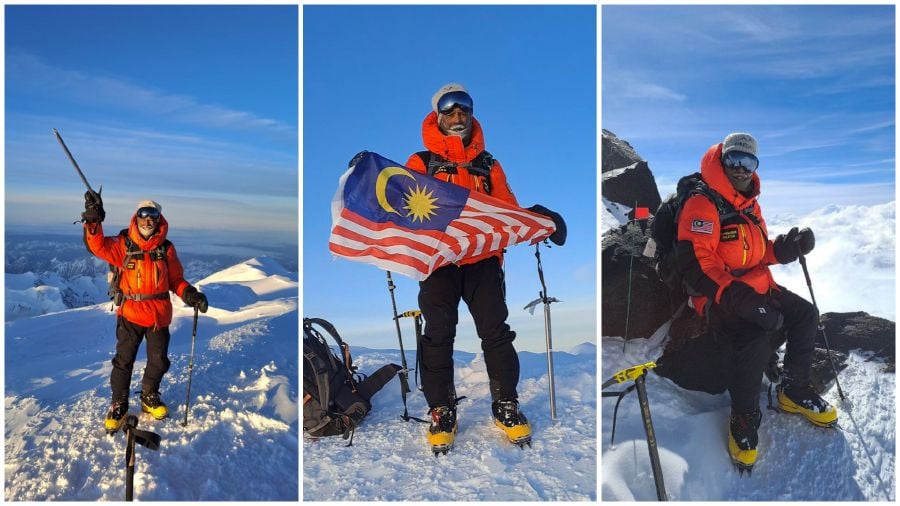REMBAU: Seeing the 'Jalur Gemilang' flying majestically on the peak of a mountain he just "conquered" never fails to fill N. Elanghovan with an overwhelming sense of pride.
It also makes him realise every sacrifice he made, including selling his house, to climb three of the world's highest mountains has been well worth it.
All the more remarkable is that he accomplished these feats in his 60s, a time when most of his peers are content with resting at home or playing with their grandchildren.
"I feel immensely proud to be able to raise the Malaysian flag each time I complete a climbing mission. And, as I gaze at the beauty of my surroundings from a mountain summit, I feel all my sacrifices have been worthwhile," said the 65-year-old Tenaga Nasional Bhd retiree who now resides in Port Dickson, Negeri Sembilan.
He told Bernama he summited three of the highest peaks in the world over a six-year period – the 5,895-metre-high Mount Kilimanjaro in Tanzania in 2018, Mount Everest (8,849 m) in Nepal four years later, and Mount Denali (6,190 m) in Alaska in the United States in June last year.
The last expedition saw Elanghovan reaching the peak of Mount Denali after 23 days of climbing without a mountain guide.

MORE CHALLENGING THAN EVEREST
He said climbing Mount Denali was the toughest experience he had ever faced, having to contend with freezing temperatures of as low as -30 degrees Celsius, along with blustery winds and snowstorms that truly tested his physical and mental strength despite being a seasoned climber.
"Mount Denali was more challenging than Mount Everest," he said, adding, "I completed the climb via five camps (Camp 1 to Camp 5) without using the services of a mountain guide. I carried all my equipment myself."
He said when he and fellow climbers reached Camp 4, they were forced to remain there for three days due to the uncertain weather.
"There were snowstorms which created whiteout conditions.And, visibility wasextremely limited… we couldn't see anything. It would have been dangerous for us to venture out as one wrong step could see us falling into a crevasse (a large, deep crack in thick ice)," he said.
Elanghovan said over there, it is considered 'good weather' if the temperature is around -10 degrees Celsius. But the minute a snowstorm strikes, the temperature plunges to -30 degrees Celsius.
He added during the Mount Denali expedition, which he undertook with a friend from India, he carried a backpack filled with essentials such as dried food, and dragged a sled on which he placed another backpack containing clothing and four portable toilets.
Climbing in snowy conditions while carrying and dragging loads, each weighing 15 kilogrammes, required immense physical strength and mental resilience.
He said setting up a tent during the snowstorm was extremely challenging as his fingers had suffered frostbite. The climbers were also required to build snow walls around their tents to reduce the impact of the cold wind.
However, all that hardship and exhaustion vanished once they reached the summit of North America's highest peak.
"The view was spectacular from the top. I was grateful for the excellent weather up there, and seeing the beautiful mountains of the Alaska Range made all my efforts seem worthwhile. I was extremely satisfied," he said.
Reflecting on his experience, Elanghovan said he understood the plight of the three Malaysian climbers who were recently stranded on Mount Denali. The incident also resulted in the death of one of the climbers.
He said at high altitudes where the weather conditions are unpredictable, climbers face risks such as frostbite, especially on the hands and feet; high-altitude cerebral edema (HACE); high-altitude pulmonary edema (HAPE); and hypothermia, all of which can be fatal.
"Alaska, located within the Arctic Circle, experiences 24-hour daylight (midnight sun phenomenon) from mid-April to mid-July. During that period, the vast snow-covered areas present additional risks. If the weather turns bad and food supplies run low, the body becomes increasingly cold, which can lead to hypothermia, HACE or HAPE," he explained.

HIGHLY EXPENSIVE
Acknowledging that mountain climbing expeditions involve hefty expenditure, Elanghovan said he had to sell his second house in Shah Alam, Selangor, using the RM300,000 he got from the sale to cover his expenses.
He added he is grateful to his wife and two children for understanding and fully supporting him despite the high risks involved.
He said in the case of the Mount Denali expedition, which cost him about RM40,000 including airfare, he chose not to hire a mountain guide as that would have set him back about US$12,000 (RM56,598).
Elanghovan said it is also vital for mountain climbers to keep themselves healthy and physically fit.
He neither smokes nor consumes alcoholic beverages, firmly believing in maintaining a healthy daily routine and always having a positive mindset.
"I was raised in Cameron Highlands (Pahang)… my house was close to the forest and hills and I used to go into the forest regularly in search of wood. The forest became my second home," said Elanghovan, who has climbed 20 of the highest mountains in Malaysia.
He said he became serious about mountain climbing when he was in his 50s. At that time, he was searching for a new activity to keep his body and mind healthy and energetic after retirement.
"There is no such thing as being too late... anyone can pursue any field or at least choose an activity that can be beneficial in old age. The most important thing is to maintain good health and take care of your diet," he said.
Elanghovan also hopes his success in conquering three of the world's highest peaks will open up opportunities for him to collaborate with various organisations, especially in fulfilling his ambition of climbing the Seven Summits, comprising the highest peak on each of the seven continents.
"But costs play a significant role, so I hope I can find organisations willing to collaborate with me on my mission.
"Even though I am in my 60s, I've confidence in my abilities, and my physical fitness is still good. I am ready to share my knowledge and experience with anyone, especially young people. Hopefully, my experience can benefit others," he said.
Among the peaks Elanghovan has set his mind on summiting are Mount Elbrus (5,642 m) in Russia; Mount Aconcagua (6,961 m) in Argentina, South America; Mount Vinson Massif (4,892 m) in Antarctica; and Mount Kosciuszko (2,228 m) in Australia. – BERNAMA





